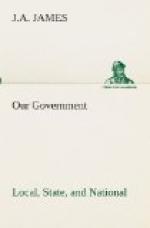The Albany Congress, 1754.—Open hostilities with their enemies became more and more frequent. From the outbreak of King William’s War, in 1689, to 1754, the date of the Albany Congress, there were at least a dozen intercolonial conferences called to consider means for the common defense. Plans for union were also prepared. The most interesting is that of William Penn. In it the word “Congress” is used for the first time in connection with American affairs. As the final struggle with France for the possession of America was about to begin, a “Congress” of twenty-five of the leading men from seven different colonies met at Albany. They were called, primarily, for the purpose of making a treaty with the Iroquois Indians. This object secured, the resolution was then unanimously adopted that “A union of all the colonies is at present absolutely necessary for security and defense.” Franklin’s famous plan providing for a permanent federation of all the colonies was also adopted. When submitted to the colonies, it failed to receive the ratification of a single one. Nor was it acceptable to the English government. Said Franklin, “The assemblies all thought there was too much prerogative, and in England it was thought to have too much of the democratic.”
The Stamp Act Congress, 1765.—After the passing of the stamp act by the English government, the Massachusetts house of representatives invited the other colonial assemblies to send delegations to a general congress. Nine colonies responded by sending twenty-eight men to the congress in New York City, October 7, 1765.[6] During the session of two weeks, these delegates drafted petitions to the English government and declared that the rights of the colonists were the same as those of the natural-born subjects of England. It is noteworthy that representatives had again assembled on the motion of the colonists themselves. The growth of common interests was well expressed by Christopher Gadsden of South Carolina, when he said: “There ought to be no New England man, no New Yorker, known on the continent; but all of us Americans.”
[Footnote 6: Virginia, New Hampshire, Georgia, and North Carolina sympathized with the movement, but did not send delegates.]
Committees of Correspondence.—Nine years were to go by before the meeting of another congress, but the colonists were prepared for a united effort at the end of this period. No sooner were the contents of the Townshend acts of 1767 known than Massachusetts issued a circular letter to the other colonies, asking for combined action against all such unconstitutional measures. The other colonial assemblies agreed with Massachusetts. Another movement which made the Revolution possible was begun by Samuel Adams. In November, 1772, he prevailed upon the Boston town meeting to appoint a committee which should carry on a correspondence with committees organized in other towns of that colony. Rights and grievances were the chief subjects for consideration. Other colonies adopted this plan. Led by Virginia, the idea was carried one step further, and in 1773 were formed committees of correspondence between the different colonies. Thus they were prepared for united action in the First and Second Continental Congresses.




